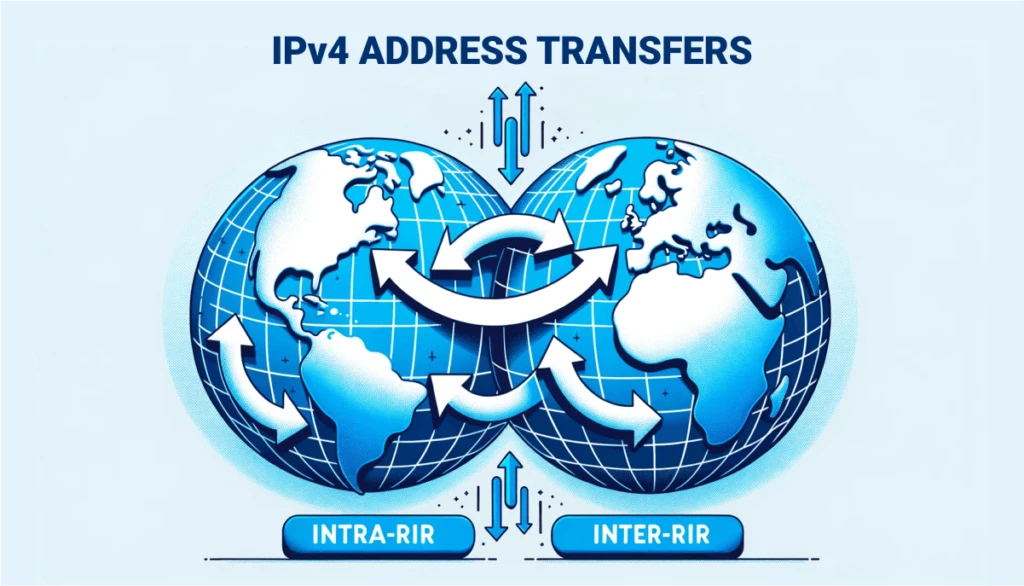Internet Protocol version 4 (IPv4) addresses are a limited resource, and as their availability has decreased, the transfer of IPv4 address rights has become a notable practice. These transfers occur between entities and sometimes across different Regional Internet Registries.
Table of Contents
Regional Internet Registries (RIRs) Explained
RIRs are organizations responsible for the allocation and registration of IP address space and Autonomous System Numbers (ASNs) within specific geographic regions. There are five primary RIRs:
- ARIN (American Registry for Internet Numbers) – for North America
- RIPE NCC (Réseaux IP Européens Network Coordination Centre) – for Europe, the Middle East, and Central Asia
- APNIC (Asia-Pacific Network Information Centre) – for the Asia-Pacific region
- LACNIC (Latin American and Caribbean Internet Addresses Registry) – for Latin America and the Caribbean
- AFRINIC (African Network Information Centre) – for Africa
Intra-RIR Transfers
Transfers that take place within the same RIR:
- For example, an organization registered under ARIN transferring IPv4 addresses to another organization that is also under ARIN would be an intra-RIR transfer.
- Each RIR has its policies and procedures for handling these transfers, ensuring that the recipient organization meets the necessary criteria to receive the address space.
Inter-RIR Transfers
Transfers that occur between two different RIRs:
- For instance, an organization under ARIN transferring IPv4 addresses to an organization under RIPE NCC would be an inter-RIR transfer.
- For such transfers to occur, both the source and receiving RIRs must have compatible, mutually agreed policies for inter-RIR transfers.
- Given the complexity of inter-RIR transfers, both the source and recipient must adhere to the policies and requirements of their respective RIRs.
In both cases, the overarching goal is to ensure the efficient and appropriate use of the limited IPv4 address space, and that transfers are legitimate and compliant with regional policies. The increasing scarcity of IPv4 addresses has made these transfer mechanisms especially important, as organizations look for ways to obtain address space for their operational needs.
Frequently Asked Questions
What are IPv4 address transfers?
IPv4 address transfers involve the movement of IPv4 address rights between entities, sometimes even across different Regional Internet Registries (RIRs), especially as the availability of IPv4 addresses has diminished.
What is the role of Regional Internet Registries (RIRs)?
RIRs are organizations tasked with allocating and registering IP address space and Autonomous System Numbers (ASNs) within specific geographic regions.
How many primary RIRs are there and what regions do they cover?
There are five primary RIRs:
– ARIN for North America
– RIPE NCC for Europe, the Middle East, and Central Asia
– APNIC for the Asia-Pacific region
– LACNIC for Latin America and the Caribbean
– AFRINIC for Africa
What is an Intra-RIR transfer?
An Intra-RIR transfer takes place within the same RIR. For instance, a transfer between two organizations both registered under ARIN would be an intra-RIR transfer.
How do Inter-RIR transfers differ from Intra-RIR transfers?
Inter-RIR transfers occur between two different RIRs. An example would be an organization under ARIN transferring IPv4 addresses to an organization under RIPE NCC.
What are the prerequisites for Inter-RIR transfers?
For Inter-RIR transfers, both the source and receiving RIRs must have mutually agreed, compatible policies for such transfers. Both parties involved must also adhere to the policies and requirements of their respective RIRs.
Why are these transfer mechanisms significant?
Given the dwindling availability of IPv4 addresses, these transfer mechanisms have gained importance. They ensure the efficient and proper use of the limited IPv4 address space and help organizations acquire address space for their operational needs while adhering to regional policies.





